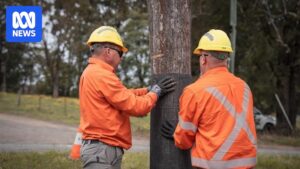
Andrea Galea vividly recalls the harrowing 2019 Black Summer bushfires that ravaged the New South Wales east coast, including her hometown of Mangrove Mountain. “When the flames came through, they were metres above the trees … it just roared through,” she recounted. “It felt like it was never going to end.”
During that time, Ms. Galea was living on her parents’ poultry and beef farm with her eight-month-old baby when the fire engulfed power poles, cutting electricity—a common occurrence for locals during extreme weather. However, a new initiative in New South Wales could change that narrative. Ausgrid has started wrapping thousands of power poles in bushfire-prone areas with protective mesh, aiming to prevent them from burning and reduce the risk of power outages.
Innovative Measures for Bushfire-Prone Areas
Learning from the devastation of Black Summer, Ausgrid is implementing this technology across the Central Coast and Hunter regions. “A lot of our more rural customers around New South Wales were out for six, seven weeks after those fires … because the poles had been damaged so badly that the lines had to be rebuilt,” explained Junayd Hollis, Ausgrid’s group executive network and digital. “This product is trying to prevent that from happening.”
The technology, which has seen success in California and parts of Canada, is not a foolproof solution for extreme bushfires like those experienced in 2019. However, it represents a proactive step in safeguarding infrastructure. “We’ve been working with the RFS to think about where the most susceptible areas are to this sort of damage,” Hollis added.
Ongoing Challenges with Burnt Poles
Ms. Galea humorously describes Warratah Road as “like a Greek tragedy,” due to frequent power losses from fallen trees, lightning strikes, and fires. Most farms in Mangrove Mountain rely on generators to maintain operations and protect livestock. Yet, the danger of burnt and damaged power poles persists long after fires, as they often fall during subsequent storms, heavy rain, or high winds.
“That’s when you get the outages … some during the fire but most afterwards,” Ms. Galea noted, pointing to blackened pole stumps and charred fencing on her property as stark reminders of the 2019 fires’ proximity. “You can still see right where it ran through,” she said.
Preparing for a Potentially Dangerous Summer
Rural Fire Service Superintendent Paul Best has collaborated closely with Ausgrid to pinpoint areas most vulnerable to bushfire damage. He emphasized the importance of the project, especially as communities brace for “what could be a dangerous bushfire summer.”
“The Central Coast and Hunter are well renowned as bushfire-prone land, and having that project being rolled out in this area is certainly great for communities to stay in touch … to keep the lights on,” Superintendent Best stated.
While the Mangrove Mountain community hopes to avoid a repeat of 2019, residents are relieved to see proactive measures being taken. “Whatever they can do to help, of course, do it, it can’t hurt,” Ms. Galea remarked. “If [Ausgrid] can keep the power on, that’s huge.”
Looking Ahead: Implications and Future Steps
The rollout of protective mesh around power poles signifies a significant investment in infrastructure resilience. As climate change continues to exacerbate weather extremes, such innovations could become increasingly vital. By collaborating with fire services and leveraging international experiences, New South Wales is taking steps to mitigate future risks.
While no technology can entirely eliminate the threat posed by severe bushfires, the measures being implemented offer a glimmer of hope for communities like Mangrove Mountain. As the summer approaches, the success of these initiatives will be closely watched, potentially setting a precedent for other regions facing similar challenges.






